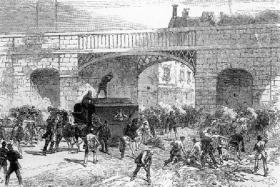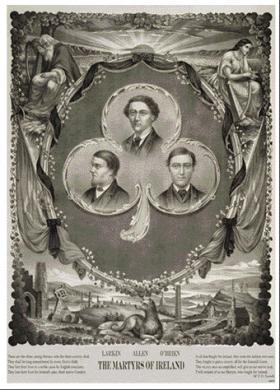The Manchester Martyrs: a Victorian melodrama
Published in 18th-19th Century Social Perspectives, 18th–19th - Century History, Features, General, Irish Republican Brotherhood / Fenians, Issue 6 (Nov/Dec 2008), Volume 16
The ‘smashing of the van’ containing Fenian prisoners Thomas J. Kelly and Timothy Deasy under the Hyde Road railway arch in Manchester, 18 September 1867. (Illustrated London News)
By the mid-1860s the Fenian movement had experienced both extraordinary growth and frustrating schism. Within a few years of its founding in 1858 it had cells throughout Ireland and the Irish diaspora, with Lancashire a notable stronghold in Britain. But its founder, James Stephens, while a consummate and energetic organiser, was also a congenital conspirator and a fatally hesitant military leader. Strategic disagreement split the American movement in 1865, whilst Stephens roused expectations of a rising in Ireland only to cancel at the last moment. In late 1866 impatience led to his replacement by Thomas J. Kelly, who arrived in Britain in January 1867. A raid on Chester Castle was betrayed and abandoned, and a rising planned for February was postponed for three weeks. When it finally took place on 6/7 March 1867, informers, official vigilance, lack of arms and severe weather rendered it ineffective. Kelly convened a secret convention in Manchester in late June and early July, where the 300 delegates confirmed his leadership. He and Timothy Deasy remained to deal with some local matters, and on 10 September they attended a nocturnal meeting at a shop in Oak Street: on leaving they were arrested.
‘Fenians of some consequence’ arrested
They were subsequently identified, allegedly on the evidence of the notorious informer John Joseph Corydon. On 18 September the Manchester Guardian seemed almost pleased to report that ‘the two men who were apprehended . . . prove to be Fenians of some consequence’. That same afternoon they appeared in the magistrate’s court and, together with 37 other prisoners, were remanded to the city jail on Hyde Road. Vague rumours of rescue had been circulating and this prompted some precautions. Kelly and Deasy were handcuffed, six constables sat on the outside of the van, Sergeant Brett, normally also on the outside, was locked inside with the prisoners, and another cab with four constables followed. None were armed. As the van passed under the Hyde Road railway arch it was ambushed by an armed party of about 40, who shot the horses, held the police at bay and attempted to break open the van with crowbars and a boulder. Making little progress, they shot the lock off the door, killing Sergeant Brett in the process, and released Kelly and Deasy.
This audacious escapade in the heart of a great British city, combined with the death of the policeman, provoked a mixture of shock, anger and indignation. The term ‘outrage’ constantly recurred. Rewards of £300 and £200 were offered by the government and Manchester Corporation for recapture. Manchester police conducted a series of raids in the city’s Irish neighbourhoods and within three days 50 were under arrest. The Guardian on 20 September reflected popular dismay and official discomfort at such a clandestine operation:
‘The Ancoats district and “Little Ireland” contain the majority of the Irish element in Manchester; but so quietly have the discontented residents in those and other parts of the city conducted their meetings that the police had little or no information whatever as to the numbers who are supposed in any way to have been connected with the Fenian movement.’
Charged under Treason Felony Act
It was decided that the 23 eventually sent for trial would be dealt with under the Treason Felony Act of 1848, which meant that anyone proven tohave been involved in the planning or execution of the offence was as guilty as those actually carrying it out. Attorney General Sir Thomas Kerslake led for the prosecution, an indication of how seriously the government regarded the affair. Sittings began on 28 October and took sixteen days, usually from 9am to 6pm, and sometimes much longer. The judges’ summing-up took two and a half hours, and the jury took 75 minutes to reach their verdicts; amongst other sentences, five men—William Allen, Michael Larkin, Michael O’Brien, Thomas Maguire and Edward Shore (actually Condon)—were condemned to hang in public at the New Bailey Prison on 23 November 1867.
During the trials it had become clear that the evidence against Maguire, a serving Royal Marine, was patent nonsense, and on 13 November he was granted a royal pardon. As the days passed, tension grew, British establishment opinion steeling itself to judicial executions as a salutary warning against subversion. Then on 19 November Condon’s sentence was commuted to penal servitude for life because of his US citizenship. These two acts of clemency led some to conclude that similar mercy could be extended to the remaining three, and their fate became the object of intense public debate and speculation in Britain and Ireland. Meetings and petitions were organised to plead for their lives on the grounds of their youth and the political nature of their motivation, the campaign finding some support in radical and intellectual circles in Britain and much more widely in Ireland. But the Courier, true to its Tory politics and its anti-Catholic and anti-Irish history, for once may have expressed majority British opinion when it declared that ‘any symptom of vacillation in dealing with the prisoners under sentence would be such a false step and productive of such evils a very large number of persons believe’.
As the date for execution drew near, tension in Manchester steadily increased and rumours abounded, including assertions that there were plans to fire warehouses and factories as cover for another rescue. The police were armed with cutlasses and revolvers; units of the Royal Artillery and Royal Engineers, a Hussar regiment and the 72nd Highlanders were moved into the city. Over 2,000 special constables were enrolled, the fire brigade were put on stand-by, and local firms enlisted employees to keep their premises staffed and illuminated the night before the executions. The prisoners were visited by local Catholic clergy and their relatives, particular attention being focused on Larkin’s mother, wife and children and Allen’s mother and fiancée. Only the cabinet could recommend mercy, but in recent months there had been a series of disturbances and murders in some cities, and the events in Manchester had re-ignited a smouldering concern about public order and social stability. Against this background, pleas for clemency were rejected.
First Irish political executions since Robert Emmet

Memorial card for Allen, Larkin and O’Brien.
Since this was to be a public execution, an upper part of the outside wall of the New Bailey Prison was removed and a platform bearing the three gibbets inserted. The morning of the execution was overcast, cold and foggy. Large crowds, marshalled by police and troops, had congregated in the surrounding streets. Shortly after eight o’clock the three men were hanged, the bodies dropping out of sight into the pit beneath the scaffold. It appears that Allen died instantly, but William Calcraft, the hangman, had bungled the job and, though Larkin quickly expired, O’Brien lingered for perhaps 45 minutes.
English newspapers reported with sober satisfaction, but the Irish reaction was very different. A deep groundswell of revulsion and anger was expressed in meetings, processions and demonstrations, often taking the form of mock funerals. The long-term political ramifications echoed throughout Ireland and, given that the events had occurred in Britain, they resonated particularly in the diaspora. These were the first Irishmen executed by the British for political crimes since Robert Emmet in 1803, and they helped to feed that highly developed sense of injustice at British hands that was such an integral feature of Irish nationalism. Three very ordinary young men were thereby recruited into the pantheon of Irish nationalist heroes as ‘the Manchester Martyrs’. The events were tailor-made for political propaganda in that they had all the characteristics of the ‘rattling good yarn’ so beloved of contemporary Victorian narrative. They included accidental arrest, identification by informer, dramatic rescue and escape, accidental murder, public panic and rumour-mongering, elaborate trial, last-minute pardon for one and reprieve for another, three grisly public hangings on a dark foggy morning and lingering doubts about a miscarriage of justice. The sequence of events closely resembled the Gothic, melodramatic, episodic nature of popular contemporary novels.
Propaganda coup
However inept the Fenians may have been in military matters, they had been gifted a priceless double propaganda coup, combining rescue and sacrifice. Sullivan’s God Save Ireland! was only the most notable of a stream of rousing songs and ballads that were to embed these events in the folklore of Irish popular nationalism. Ceremonies on the Sunday closest to 23 November became the longest-running commemorative ritual in Irish nationalism. Both the Catholic Church and moderate nationalist politicians climbed hurriedly on the bandwagon, and in the years to come they carefully passed over early anathemas and the secret, violent, separatist nature of the Fenian movement in favour of homilies and speeches on the exemplary piety, bravery and patriotism of the three men. Not for the first or the last time, an act of the British government intended to mollify British public opinion and to impress the Irish with firmness backfired by mobilising nationalist sentiment. Even in the early twenty-first century there was talk in Manchester that the final burial place of the Martyrs had been discovered and that it was time to exhume them and rebury them in Glasnevin. Clearly they haven’t gone away!
Mervyn Busteed lectures in the School of Environment and Development at the University of Manchester.
Further reading:
M.A. Busteed, ‘The Irish in nineteenth-century Manchester’, Irish Studies Review (1997).
A. Glynn, High upon the gallows tree (Tralee, 1967).
J. Newsinger, Fenianism in mid-Victorian Britain (London, 1994).
G. Owens, ‘Constructing the martyrs: the Manchester executions and the nationalist imagination’, in L. McBride (ed.), Images, icons and the Irish nationalist imagination (Dublin, 1999).
















